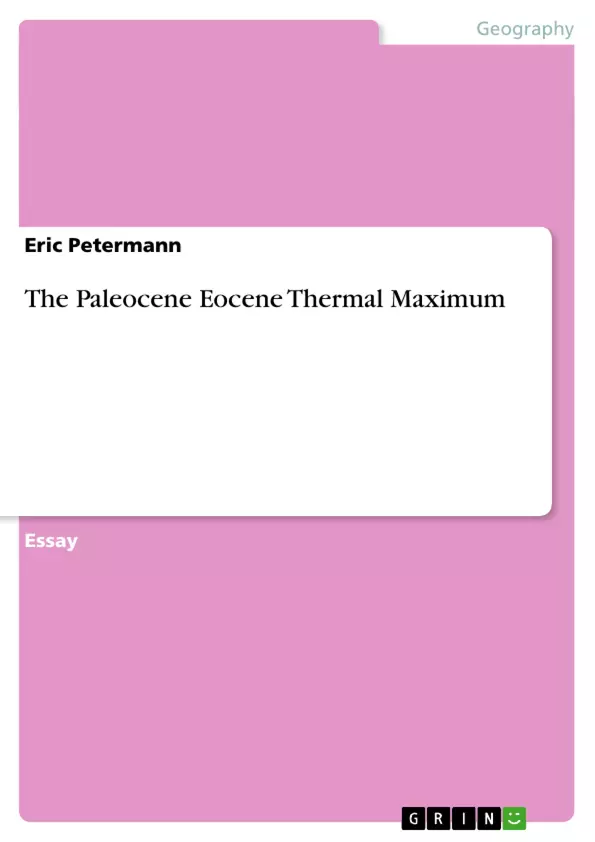At the Paleocene/Eocene boundary (55 Ma BP) a general global warming trend was overruled by an outstanding 4-6 °C (Dickens et al. 1997; Zachos et al. 2001) short-term warming event. This information is derived from a -2 to -3‰ negative δ 18O excursion accompanied by an -2.5 ‰ δ13C excursion (Fig.1). Both isotope excursions occur simultaneously and reach their minimal values very rapidly within less than 10 ka. They return to initial values after ~200 ka. PETM climate conditions resulted in extinction of archaic mammals while modern mammalian ancestors have appeared as well as in extinction or temporal disappearance of many deep-sea species (Dickens et al. 1997).
δ 18O values of benthic foraminifera of all oceans and planktic foraminifera at high-latitude locations are marked by a sharp decrease (Fig.1) indicating a striking global temperature increase of the deep-sea and high-latitude surface water temperatures (Dickens et al. 1997). A simultaneous negative δ13C excursion is documented in marine as well as in terrestrial environments all over the world. The carbon isotope excursion is attributed to the release of massive quantities of biogenic methane (δ13C = -60‰) adding large amounts of 12C to the inorganic carbon reservoir. Mass balance calculations suggest a transfer of 1400 to 2800 Gt (Dickens et al.1997) respectively 1500 to 2200 Gt (Katz et al. 2001) of CH4 to the ocean/atmosphere system to explain the negative carbon isotope excursion.
Inhaltsverzeichnis (Table of Contents)
- Introduction
- Triggering Mechanisms and Climate Feedback Loops
- Thermal Dissociation
- Mechanical Disruption
- Conclusion
Zielsetzung und Themenschwerpunkte (Objectives and Key Themes)
This paper examines the Paleocene/Eocene Thermal Maximum (PETM), a significant warming event that occurred approximately 55 million years ago. It investigates the triggering mechanisms and climate feedback loops associated with the release of methane from gas hydrates during this event. The key themes explored in the text are:- The role of methane release from gas hydrates in driving global warming
- The contrasting hypotheses of thermal dissociation and mechanical disruption as triggers for methane release
- The impact of the PETM on deep-ocean circulation and its implications for climate change
- The importance of climate feedback loops in amplifying the warming effect
- The long-term consequences of the PETM on the Earth's climate and ecosystems
Zusammenfassung der Kapitel (Chapter Summaries)
- Introduction: This section introduces the PETM, highlighting the significant global warming event that occurred at the Paleocene/Eocene boundary. It presents the key features of the event, including the negative δ18O and δ13C excursions, and discusses the resulting climatic and biological impacts.
- Triggering Mechanisms and Climate Feedback Loops: This chapter explores the two main hypotheses proposed for triggering the methane release: thermal dissociation and mechanical disruption. It examines the supporting evidence for each hypothesis and discusses their respective strengths and weaknesses. The chapter also analyzes the role of climate feedback loops in amplifying the warming event, including the impact of increased hydrological cycles and changes in oceanic circulation patterns.
Schlüsselwörter (Keywords)
The primary keywords and focus topics of this research encompass the Paleocene/Eocene Thermal Maximum (PETM), global warming, methane release, gas hydrates, thermal dissociation, mechanical disruption, climate feedback loops, oceanic circulation, deep-sea temperature, carbon isotopes, and δ13C and δ18O excursions. This study focuses on the interplay between these factors in understanding the PETM event and its long-term consequences for the Earth's climate.- Arbeit zitieren
- Eric Petermann (Autor:in), 2009, The Paleocene Eocene Thermal Maximum, München, GRIN Verlag, https://www.hausarbeiten.de/document/139188


